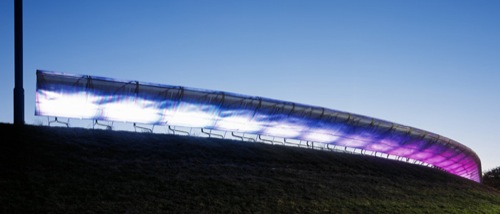The Daycaster
The DayCaster stands at the eastern edge of Exeter, Devon, welcoming the traveller with a curved gateway of coloured light. It was designed by architects Sutherland and Hussey in 2004 to celebrate the move to Exeter of the UK's premier weather forecasting institution, the Met Office, whose new headquarters are nearby.

The Daycaster provides an ever-changing display of coloured light that records recent changes in the weather. There are 24 banks of 3 LEDs, one for each of the previous 24 hours. Data collected by the Met Office is downloaded every hour to a small computer, which compares the readings with the average for the current season. The differences are combined to generate a single colour. When warmer and drier than average, the segment tends towards magenta; when colder and wetter, the segment tends towards blue. Average conditions are shown as a neutral (or white) light.

If you watch the DayCaster for a whole day, you'll see the colours shift slowly left. The segment at the rightmost end indicates the weather conditions during the last hour; the colours slide to the left, one segment an hour, until it eventually disappears off the left end 24 hours later. When you look at the DayCaster, you're seeing the previous day at a glance.
Of course, the above descriptions refer to the Daycaster as it was originally designed. Unfortunately, after more than ten years, time and the weather have taken their toll, and the Daycaster, long neglected by cash-strapped Exeter City Council, now rarely works at all.
Find the Daycaster on Google Maps
View Larger Map